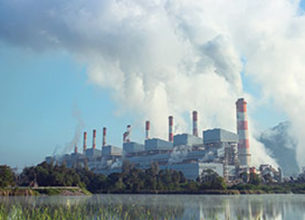CARBON TRADING & CLIMATE CHANGE
11, Jan 2020

Prelims level : Climate change and its Impacts
Mains level : GS-III Conservation, Environmental Pollution and Degradation, Environmental Impact Assessment
- “Future generations will judge us harshly if we fail to uphold our moral and historical responsibilities”
- Climate Change is the defining issue of our time. From shifting weather patterns that threaten food production, to rising sea levels that increase the risk of catastrophic flooding, the impacts of climate change are global in scope and unprecedented in scale. Without drastic action today, adapting to these impacts in the future will be more difficult and costly.
What are Greenhouse Gases and How do the affect the Global Climate?
- Greenhouse gases occur naturally and are essential for the survival of living beings including humans.
- They help their survival, by keeping some of the Sun’s warmth from reflecting back into space and making the Earth habitable.
- As populations, economies and standards of living grew – human activities like industrialization, deforestation, and large-scale agriculture have increased the quantities of greenhouse gases in the atmosphere.
- The concentration of GHGs in the earth’s atmosphere is directly linked to the average global temperature on Earth.
- The concentration has been rising steadily, and mean global temperatures along with it, since the time of the Industrial Revolution.
- Carbon dioxide (CO2), accounting for about two-thirds of GHGs, is largely the product of burning fossil fuels.
What is a Carbon Offsetting and what are offsetting projects?
- A carbon offset broadly refers toreduction in GHG emissions – or an increase in carbon storage (e.g., through land restoration or the planting of trees) – that is used to compensate for emissions that occur elsewhere.
- A carbon Offset Project, May Involve:
- Renewable energy development (displacing fossil-fuel emissions from conventional power plants);
- The capture and destruction of high-potency GHGs like methane, N2O, or HFCs; or
- Avoided deforestation (which can both avoid the emission of the carbon stored in trees, as well as absorb additional carbon as trees grow).
What are Carbon Credits?
- A carbon credit (often called a carbon offset) is a tradable certificate or permit.
- One carbon credit is equal to one tonne of carbon dioxide emitted.
- Carbon credits can be acquired through afforestation, renewable energy, CO2 sequestration, methane capture, buying from an exchange (carbon credits trading) etc.
- Carbon credits are traded at various exchanges across the world.
What is Carbon Trading?
-
- It is a market-based system aimed at reducing greenhouse gases that contribute to global warming, particularly carbon dioxide emitted by burning fossil fuels.
- The process involves buying and selling of permits and credits to emit carbon dioxide, it uses the Cap and Trade mechanism to achieve the reduction in Emissions.

What does Cap and Trade Mean?
- It is also called as Emission Trading.
- The system works by setting an overall limit or cap on the amount of emissions that are allowed from significant sources of carbon, including the power industry, automotive and air travel.
Kyoto Protocol and Carbon Trading:
- The Kyoto Protocol is an international agreement linked to the United Nations Framework Convention on Climate Change (UNFCCC), which commits its Parties by setting internationally binding emission reduction targets.
- Kyoto Protocol allows countries that have emission units – to sell this excess capacity to countries that are over their targets.
- Parties with commitments under the Kyoto Protocol (Annex B Parties) have accepted targets for limiting or reducing emissions.
- These targets are expressed as levels of allowed emissions, or assigned amounts, at over the 2008-2012 commitment period.
- The allowed emissions are divided into assigned amount units (AAUs).
- A new commodity is created in the form of emission reductions or removals.
- Since carbon dioxide is the principal greenhouse gas, people speak simply of trading in carbon. Carbon is now tracked and traded like any other commodity. This is known as the “Carbon Market.”
Other trading units under Kyoto Protocol:
- More than actual emissions units can be traded and sold under the Kyoto Protocols emissions trading scheme. The other units which may be transferred under the scheme, each equal to one tonne of CO2, may be in the form of:
- A Removal Unit (RMU) on the basis of land use, land-use change and forestry (LULUCF) activities such as reforestation
- An Emission Reduction Unit (ERU) generated by a joint implementation project
- A Certified Emission Reduction (CER) generated from a clean development mechanism project activity
- Transfers and acquisitions of these units are tracked and recorded through the registry systems under the Kyoto Protocol.








